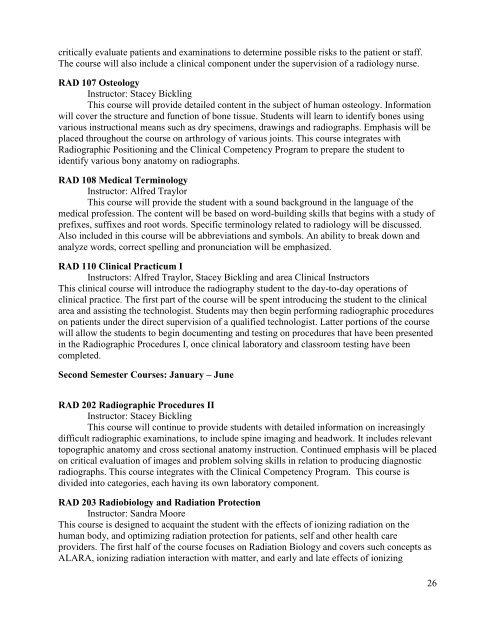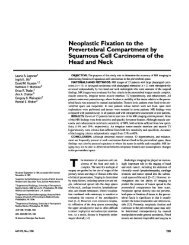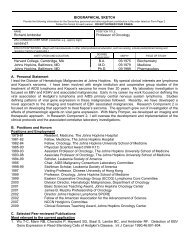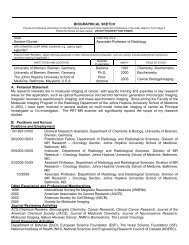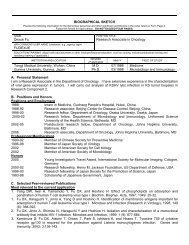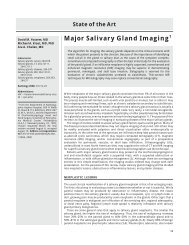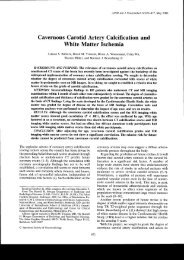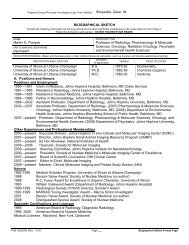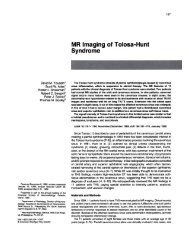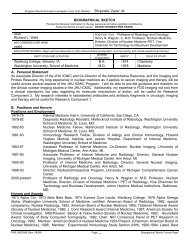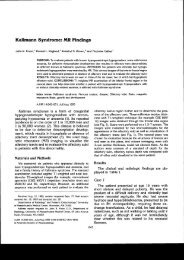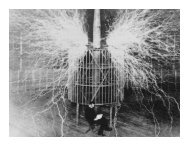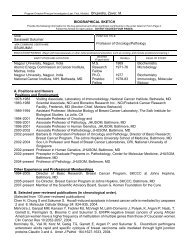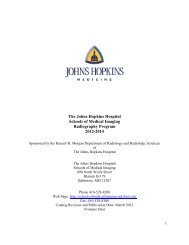The Johns Hopkins Hospital Schools of Medical Imaging ...
The Johns Hopkins Hospital Schools of Medical Imaging ...
The Johns Hopkins Hospital Schools of Medical Imaging ...
You also want an ePaper? Increase the reach of your titles
YUMPU automatically turns print PDFs into web optimized ePapers that Google loves.
critically evaluate patients and examinations to determine possible risks to the patient or staff.<br />
<strong>The</strong> course will also include a clinical component under the supervision <strong>of</strong> a radiology nurse.<br />
RAD 107 Osteology<br />
Instructor: Stacey Bickling<br />
This course will provide detailed content in the subject <strong>of</strong> human osteology. Information<br />
will cover the structure and function <strong>of</strong> bone tissue. Students will learn to identify bones using<br />
various instructional means such as dry specimens, drawings and radiographs. Emphasis will be<br />
placed throughout the course on arthrology <strong>of</strong> various joints. This course integrates with<br />
Radiographic Positioning and the Clinical Competency Program to prepare the student to<br />
identify various bony anatomy on radiographs.<br />
RAD 108 <strong>Medical</strong> Terminology<br />
Instructor: Alfred Traylor<br />
This course will provide the student with a sound background in the language <strong>of</strong> the<br />
medical pr<strong>of</strong>ession. <strong>The</strong> content will be based on word-building skills that begins with a study <strong>of</strong><br />
prefixes, suffixes and root words. Specific terminology related to radiology will be discussed.<br />
Also included in this course will be abbreviations and symbols. An ability to break down and<br />
analyze words, correct spelling and pronunciation will be emphasized.<br />
RAD 110 Clinical Practicum I<br />
Instructors: Alfred Traylor, Stacey Bickling and area Clinical Instructors<br />
This clinical course will introduce the radiography student to the day-to-day operations <strong>of</strong><br />
clinical practice. <strong>The</strong> first part <strong>of</strong> the course will be spent introducing the student to the clinical<br />
area and assisting the technologist. Students may then begin performing radiographic procedures<br />
on patients under the direct supervision <strong>of</strong> a qualified technologist. Latter portions <strong>of</strong> the course<br />
will allow the students to begin documenting and testing on procedures that have been presented<br />
in the Radiographic Procedures I, once clinical laboratory and classroom testing have been<br />
completed.<br />
Second Semester Courses: January – June<br />
RAD 202 Radiographic Procedures II<br />
Instructor: Stacey Bickling<br />
This course will continue to provide students with detailed information on increasingly<br />
difficult radiographic examinations, to include spine imaging and headwork. It includes relevant<br />
topographic anatomy and cross sectional anatomy instruction. Continued emphasis will be placed<br />
on critical evaluation <strong>of</strong> images and problem solving skills in relation to producing diagnostic<br />
radiographs. This course integrates with the Clinical Competency Program. This course is<br />
divided into categories, each having its own laboratory component.<br />
RAD 203 Radiobiology and Radiation Protection<br />
Instructor: Sandra Moore<br />
This course is designed to acquaint the student with the effects <strong>of</strong> ionizing radiation on the<br />
human body, and optimizing radiation protection for patients, self and other health care<br />
providers. <strong>The</strong> first half <strong>of</strong> the course focuses on Radiation Biology and covers such concepts as<br />
ALARA, ionizing radiation interaction with matter, and early and late effects <strong>of</strong> ionizing<br />
26


